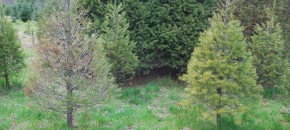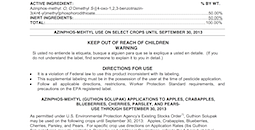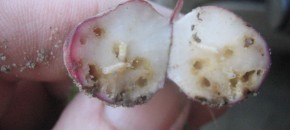From The Blueberry Bulletin April 3, 2013 Upcoming Twilight Meetings Wednesday, April 24, 2013 Variety Farms 548 Pleasant Mills Rd. Hammonton, NJ 08037 Thursday, May 30, 2013 @ 5:30 Atlantic Blueberry Co. 7201 Weymouth Rd., Hammonton, NJ For Directions, Call 609-561-8600 Blueberry IPM Plum Curculio: One adult was seen in a beating tray sample, indicating […]
Continue reading...Needles may fall…
Now is the time to monitor for two common diseases of Douglas fir: Rhabdocline needlecast (caused by the fungus Rhabdocline pseudotsugae) and Swiss needlecast (caused by the fungus Phaeocryptopus gäumannii). Rhabdocline needlecast is well established in New Jersey Christmas tree plantations, and Swiss needlecast has become more common. The discriminating grower wants to know, “what’s […]
Continue reading...Hold on to Your Needles!

As the weather warms, Christmas tree growers and nursery folks are beginning to get back into their fields to select trees for digging or to assess field conditions. Recent samples in the Plant Diagnostic Laboratory suggest it would be prudent to keep an eye out for disease symptoms and signs that would have appeared or […]
Continue reading...Perennial Weed Control Using Cultural/Mechanical Techniques
Most annual and perennial weeds reproduce from seed, but many perennials also reproduce vegetatively. Examples of vegetative reproductive parts of weeds include stolens, rhizomes, roots, tubers, bulbs, and nutlets. Bermudagrass has stolens, which are above ground horizontal stems. Quackgrass spreads by rhizomes, which are underground horizontal stems. Canada thistle, milkweed, hemp dogbane, horsenettle, and bindweed […]
Continue reading...Guthion Use in Parsley

The Environmental Protection Agency has extended the time for the use of existing stocks of Guthion (azinphos-methyl) in parsley and certain tree fruit crops. A supplemental label was registered for 2013 allowing the use of guthion until September 30. Guthion can no longer be purchased and is in a 6 year phase out period.
Continue reading...Early Spring Insect Pests

With a cold, wet March, the spring crops have been slow to be put in, and consequently there have been few pest concerns. However, this will change with the onset of temperatures nudging 60⁰ F and drier conditions. There is always the question of how well did the insects survive the winter.
Continue reading...